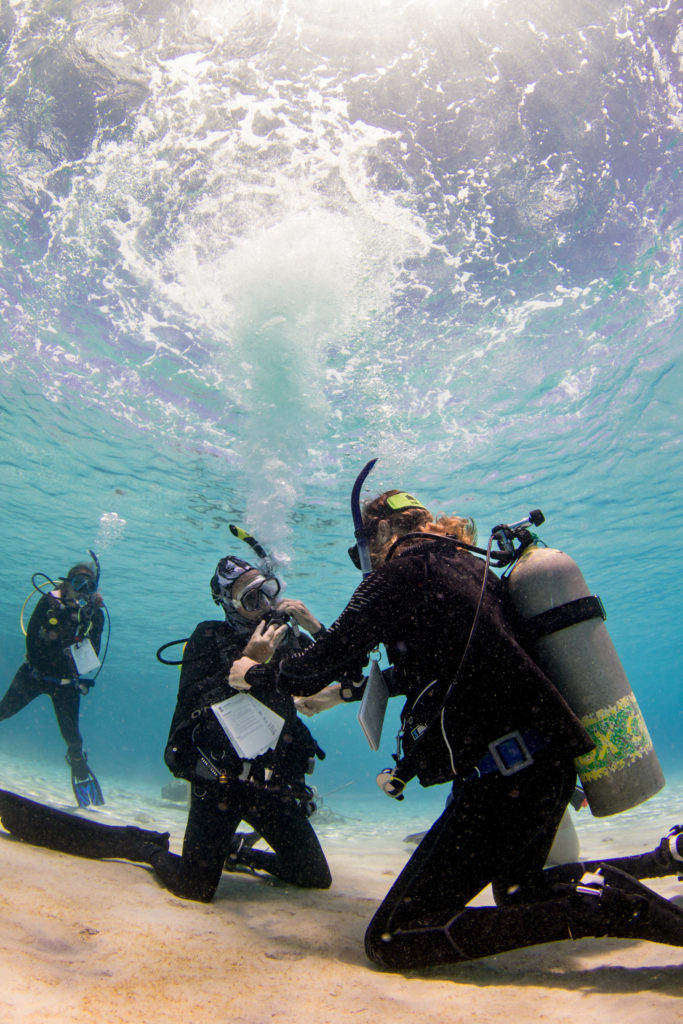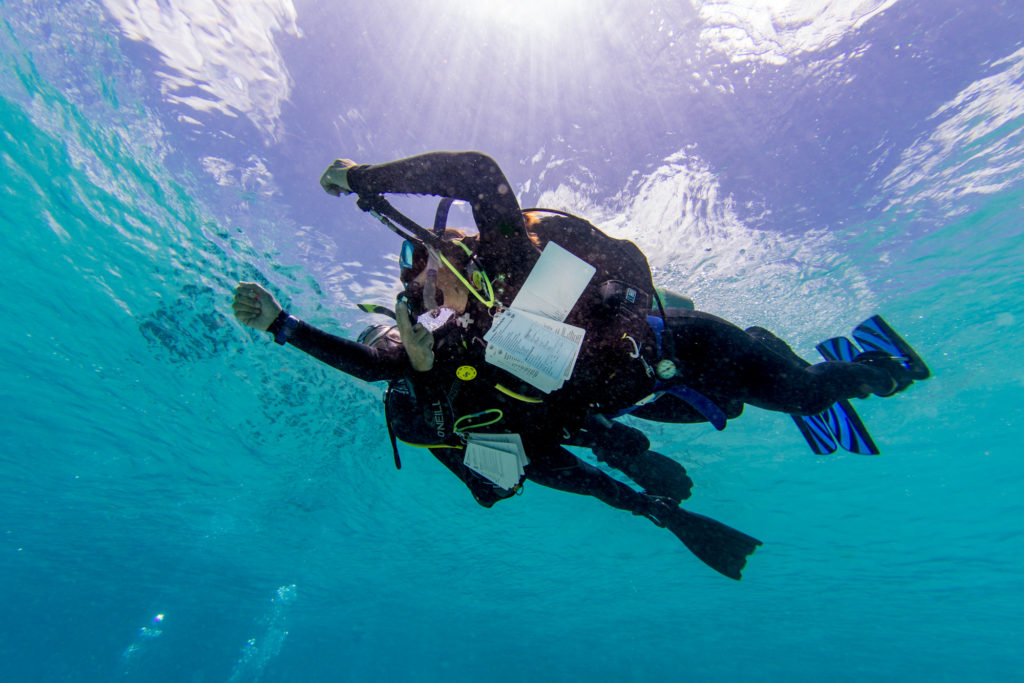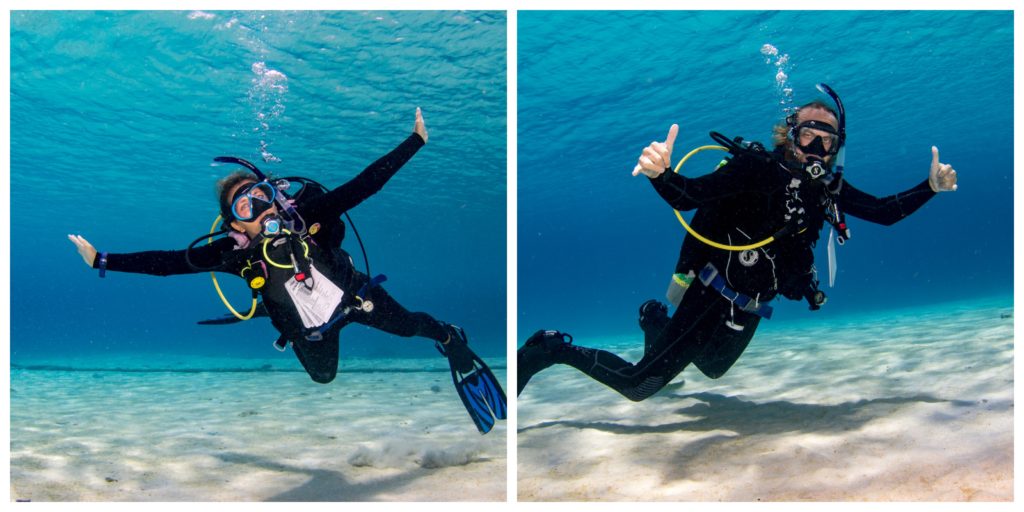PADI IDC & IE
After 19 long days, we’re MSDTs (Master Scuba Diver Trainers)! We just need 25 certifications to make the rating official. An MSDT can teach everything from discover scuba through divemaster.
Thinking of taking the leap? Here’s how it went for us ….
To become a PADI instructor you have to take an Instructor Development Course (IDC) then pass the Instructor Exam (IE). The IE is a two-day test administered by a PADI examiner who evaluates your knowledge of diving, ability to teach in the classroom & water, your understanding of PADI’s standards, and your rescue abilities.
What to expect in your IDC:
Pick your course director well! You’re going to spend 14 long days together (19-20 with MSDT), sometimes more than 10 hours a day so I can’t emphasize enough how important it is that you click with them. If you can Skype with them before you commit, do it! Same goes for IDC Staff Instructors that will be part of your course. If you’re not getting a good vibe trust your gut and go elsewhere. Our instructors were fantastic and that made for a great experience.
Beyond that, here’s what to expect in the day-to-day:
- Classroom presentations to learn all the things.
- You’ll learn the formula for the theory presentation you’ll do as part of the IE. You’ll also do a few practice presentations to get it dialed in.
- Mock exams – both theory and standards. We took two of each. If you do well on these you should be just fine on the exam.
- Physics workshop – a lot of people struggle with the physics section so we had a half-day workshop.
- In the water:
- Skill evaluation – your instructors will evaluate your demonstration of the 20 basic SCUBA skills and help you perfect them. Your skills should already be solid. This isn’t the time or place to learn the skills themselves but how to teach them to others. GO SLOW!
- Practice giving confined water presentations and learning how to hit the points on the scoring model used in the IE

- Practice open water presentations
- Practice CESA (Controlled Emergency Swimming Ascent) – both horizontally in confined and vertically in open water. This skill WILL be part of the IE so make sure you have it nailed down ahead of time. We had a half-day workshop on it and practiced throughout the IDC.

- Rescue 7 – part of the IE is performing a demonstration quality Rescue 7. You’ll be assigned to do it with the pocket-mask or mouth-to-mouth so make sure you’re comfortable doing it both ways.
- 800M swim. You can do this with mask, snorkel, and fins and it’s untimed.
What to expect at the IE:
Ahhh the IE. This is what you’ve been working toward for the past two weeks. No matter how well prepared you are, you will be nervous. Hopefully your Course Director had you repeat everything enough times even your nerves won’t get in the way of a great score on all of the sections.
The most stressful part of the IE is making a failing mistake. There are mistakes that will get you a low score and mistakes that are an automatic fail.
The IE kicks off with an orientation where you’ll receive a folder with all of your assignments & makeup assignments (which you hopefully won’t need!). Below is the order our exam was administered.
- Written exams – both theory and standards
- Theory contains five sections: physics, physiology, equipment, skills & environment, and the RDP. There are twelve questions in each section and you must score at least a 75% in each section to pass. If you fail one section you can retake that section later in the IE. If you fail two or more you have to come back to a future IE and retake the whole exam.
- Standards – open book and you’ll need a 75% to pass. There’s no makeup if you fail – you’ll have to go to another IE to retake it.
- Theory Presentation – hit the scoring points and you’ll be fine and if you’re not, you can do it again in the same IE so don’t stress this one. Your topic (and makeup topic) will be given to you at the orientation.
- Confined Water Presentation – hit the points in your briefing and debriefing and DON’T FORGET TO DEMO THE SKILL. Not demonstrating the skill is an automatic failure. Spot your “students” problems and you’ll be just fine. And if you totally blow it? You can redo it during the same IE so don’t stress. You’ll present one skill here assigned during orientation.
- Confined Water Skill Circuit – you’ll get the skills during the IE orientation and the scoring model will be explained. If you fail there’s no retake, you’ll have to go to another IE to redo it. Tip: GO SLOW. If you think you’re doing it ridiculously slowly, do the skill even slower.
- Open Water Presentation – you’ll teach two skills in the open water. The IE examiner will assign problems to your “students” just like you practiced in your IDC. You can get an instant 1 which is a failing score if you miss something critical and you’ll have to go to another IE to repeat this section. But don’t worry about that because you’re going to be fine….
- Think through your assigned open water skills what could go wrong and plan for how you’ll handle it. I had neutral buoyancy with the power inflator for instance. I knew one problem would be someone mashing on their inflator and zooming to the surface – if I let that happen, that’s a 1. Get very close to your “students” and study their gear ahead of time. Know where their dump valves are, etc and play through the mistakes in your head.
- Rescue 7 – you will need to perform a demonstration quality Rescue 7. Your assignment sheet will tell you whether you’re using the pocket-mask or mouth-to-mouth. You should have practiced both in your IDC and feel very comfortable with the steps. GO SLOW. It’s demo quality not a real rescue. If you need to just chill and collect yourself through a few rescue breath cycles, do it. If you have the pocket-mask, put it on your arm before you head into the water to prevent fiddling around to find it. This is a pass or fail. You can redo it once but you won’t have to if you go slow and follow the steps.
What to do ahead of your IDC:
- Study up on everything. The “Diving Knowledge” workbook that goes with the “Encyclopedia of Diving” is a great resource. Roatan Divers also has a great learning center with videos, explanations and practice quizzes free of charge.
- Watch demonstration quality videos of the skills. There are a bunch on YouTube.
- Get in the water and practice demoing the skills! As divers, we don’t generally spend our time in the water teaching people how to clear masks and recover regs so of course you need some practice.
- If you’re not in shape, start swimming if you can for the 800M swim. You just have to finish it but it might feel far if you haven’t been swimming in a while.
Try to have some fun along the way too!

If you have any questions beyond what I covered here, comment or email me and I’ll be sure to answer it!
Happy Bubbles!
